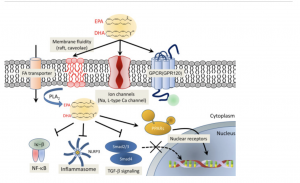When addressing the role of the high fat diet and obesity, it is important to evaluate the types of fats in a given diet. While a high fat diet can lead to increase in obesity, a low fat diets as intervention for obesity is not supported. Rather, increasing the intake of unsaturated fatty acids over saturated fatty acids, carbohydrates, and proteins, can be beneficial for the obese population. Therefore, one must evaluate the types of fat intake that one is receiving, and aim to increase and supplement polyunsaturated fatty acids and some monounsaturated fatty acids when reversing obesity and insulin resistance.
So, what are the types of fat? Which types are “good?”
Trans fat is a byproduct of hydrogenation that is used to turn healthy oils into solids to prevent from becoming rancid. It has no known health benefits and is banned in the United States. It is known to increase the amount of LDL cholesterol in the bloodstream, while reducing the good, HDL, cholesterol. It also causes massive inflammation, and contribute to insulin resistance.
Saturated fats are solid at room temperature. They are found in red meats, whole milk, cheese, coconut oil, and baked goods, etc. A diet that is rich in saturated fats can increase total cholesterol.
Monounsaturated and polyunsaturated fats are good fats that come from vegetables, fish, nuts and seeds. In particular, monounsaturated fats have a single carbon to carbon double bond. Foods such as olive oil, avocados, nuts, and foods familiar to the “Mediterranean diet” are high in monounsaturated fats. Polyunsaturated fats are essential fats. They are required for normal body functions and humans need to obtain them from food sources. They have two or more double bonds. They are used for many different processes in the body, mainly for building cell membranes, cover our nerves, and are used in blood clotting, muscle movement, and controlling inflammation. Eating polyunsaturated fats instead of saturated fats or highly refined carbohydrates reduces LDL cholesterol and lowers triglycerides. The two main types of polyunsaturated fats are omega-3 and omega-6 fatty acids.
Omega-3 fatty acids can be found in salmon, flaxseeds, walnuts, and mackerel, shrimp, hemp and chia seeds, among others. Omega-3 fatty acids are known to prevent and treat heart disease and stroke, they reduce blood pressure, raise HDL, lower triglycerides, and restore leptin and insulin sensitivity, especially in the obese population. The figure below shows how omega-3 PUFAs protect cell membranes through exerting anti-inflammatory effects through modulating NF-kB signaling, NLRP3 inflammasome, PPARa/y, GPR120, and TGF-B signaling. Omega-6 food sources include vegetable and corn oils, sunflower seeds, peanut butter, eggs, and almonds, and they have been linked to protect against heart disease.
The ratio of omega-3 to omega-6 fats is important, especially in regards to inflammation and it is recommended that rather than decreasing the amount of omega-6s in your diet, which can be anti-inflammatory, it is better to increase your omega-3 intake.

Overall, while some fats are harmful to our health and bodily functions, and contribute to diseases like obesity and insulin resistance, high quality fats like polyunsaturated fatty acids can actually protect and reverse obesity and insulin resistance.
